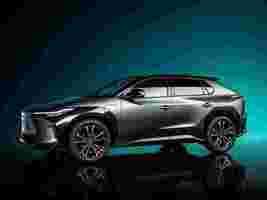This chart shows how Paris is cleaning up its transport
This article was written by Choose Paris Region on The Urban Mobility Daily , the content site of the Urban Mobility Company, a Paris-based company which is moving the business of mobility forward through physical and virtual events and services. Join their community of 10K+ global mobility professionals by signing up for the Urban Mobility Weekly newsletter . Read the original article here and follow them on Linkedin and Twitter .

Aiming for an ambitious decarbonization strategy to meet sustainability and air quality objectives, The Paris Region is on track to significantly reduce its carbon emissions within the upcoming years. With 40 million daily trips taken in and around Paris, one major strategy the Region is taking to accomplish this mission concerns an environmentally responsible restructuring of local mobility.
With an ideal innovation ecosystem and some of the biggest players in transportation heading up shifts within the industry, discover this infographic and learn about the specific details driving the Paris Region’s clean mobility plan, as well as the support offered to make the transition as smooth as possible.


Do EVs excite your electrons? Do ebikes get your wheels spinning? Do self-driving cars get you all charged up?
Then you need the weekly SHIFT newsletter in your life. Click here to sign up .
No, Hyundai is not ending its love affair with hydrogen or ICEs
It’s been a busy week for Hyundai, who had to refute claims it was breaking up with hydrogen. This week, we saw yet another claim by an “industry insider” that Hyundai had suspended their R&D in 3rd generation hydrogen fuelcells.

An article by Korean news outlet Chosun Biz claimed that Hyundai had suspended R&D in 3rd generation hydrogen fuel cells due to technical problems and a lack of marketability.
That’s apparently not true; an unnamed Hyundai Motor official issued a statement today to the Korea Times refuting the claim:
No, Hyundai is not closing down its ICE development either
The hydrogen news was hot on the heels of the claim that Hyundai was closing down its Internal Combustion Engine R&D and moving the 12,000-odd staff to electric vehicle departments.
Just a few hours ago, an e-mail sent to Motor1om from Senior Group Manager at Hyundai Motor America, Michael Stewart, said:
Inaccurate media stories have consequences
Honestly, I’m starting to wonder if these industry insiders are paying fans of rival companies looking to cause affray.
In the case of the hydrogen claim, investors reacted adversely to the news. According to The Korea Times , companies affiliated with Hyundai and/or working on fuel cell tech saw share prices drop by 4%-10% following the report.
It looks like investors are taking their cues from the media, and I’m not sure that’s a good thing. Shouldn’t they be paying analysts for a more long-term vision?
Hyundai’s hydrogen fuel cell dream is evolving — albeit slowly
In 2018, the South Korean government and Hyundai set an annual production goal of 130,000 hydrogen cars by 2025′ and ‘80,000 hydrogen cars sold by 2022. So far, retail sales are not even close anywhere in the world.


In 2021, sales of HFC vehicles almost doubled compared to the previous year. 16,300 vehicles were registered from January to December 20201. 8900 of these were Hyundai Motor’s sole fuel cell EV Nexo , which increased its sales by 46% compared to the previous year.
In September last year, Hyundai announced its Hydrogen Vision 2040 at an online event called Hydrogen Wave . It doubled down on its aim to become the first automaker to apply fuel cell systems to all commercial vehicle models by 2028.
This is part of a bigger mission introducing hydrogen fuel cells into high-performance vehicles. These include urban air mobility , robots, aircraft , and large ships.
Hyundai Engineering Co., a construction unit of Hyundai Motor Group, is spending $336 million to build a plant to produce hydrogen from plastic waste. The company expects to raise up to $1.2 billion in a planned initial public offering (IPO) early this year.
The pain point is hydrogen refueling stations
Hydrogen fuel cell-powered vehicles share the woes that plagues EV users — both lack easy access to charging or power. At the end of 2020, 553 hydrogen refueling stations were in operation worldwide.
In 2018, a collective of industry leaders and the government pledged to have 310 hydrogen refueling stations in South Korea by 2022.
At the end of 2020, there were a mere 60. That’s a pretty dire shortfall. There are just under 400 EV charging stations in South Korea by comparison.
Most applications for hydrogen are industries — ships, trains, buses, VTOLs, and trucks. These typically have access to on-site refueling at truck parking bays, shipyards, bus, and train depots.
But for hydrogen fuel cell cars to succeed, the infrastructure needs to catch up, leaving a chicken and egg problem where companies are trying to balance the long-term snail pace of commercial hydrogen fuel cell evolution with the rapid acceleration of electric vehicles.
Prepare to pay more for car updates with 3G sunsetting
Car manufacturers have long been generating money through s ubscription over-the-air (OTA) software updates. But with 3G capabilities set to expire in 2022, things could get even more expensive for car owners.

OTA updates are a hot topic for vehicles owners who resent paying for new services. I reported earlier in the year about Mercedes-Benz introducing an OTA subscription update to the all-electric luxury salon Mercedes-Benz EQ to modify the rear-axle steering with a ten-degree steering angle .
Fast-forward to this week, Toyota has consumers up in arms by setting an end date to free subscriptions for key fob remote start capabilities . This functionality is now only available with a Remote Connect subscription. for many drivers. Via a corresponding mobile app, the key fob makes it possible for drivers to monitor, lock, or start their cars with their smartphones.
According to Toyota , vehicles with Premium Audio can trial the feature for the next three years, and with the newer Premium Audio up to 10 years. But otherwise, car owners will need to pay for a subscription to continue using the key fob’s remote start. It’s a price of either $8 a month or (currently) $80 a year. That’s a lot of money for something you’ve previously enjoyed for free.


You may own your car, but you don’t own its functionality
We may have purchased the car outright, but OTA updates and a subscription model mean we’re still at the behest of the services and updates that the company chooses to share with us. We own the car, but the company owns the software.
And we really should have learned from the pain of smart homes. IoT-connected homes have a graveyard of failures. A company goes bust or is acquired. It stops supporting older devices or updating the device’s software. A security problem forces the device out of operation. Or legislation is passed that updates the law (as in the state of Massachusetts, for example) regarding the right to repair your own devices. Or technology standards evolve faster than the IoT device.
Long term, the goal of car makers is to eliminate privately owned vehicles. Instead, we’ll pay for a subscription service for autonomous vehicles to pick us up and drive us where we need to go.
But until then, I have many questions about how OTAs will play out:
Should IoT-connected services have a minimum lifespan of functionality after the sale of a car model ends?
If we buy a car with certain software subscription features, should we be able to take this subscription to the next car we buy from the OEM?
What happens if we sell it second-hand?
Does the new owner have to pay again for the same software service?
What rights do we have to the subscriptions we’ve paid for? ( Very little, it seems.)
Pissed off by OTA updates? Wait until you have to deal with 3G sunsetting!
While many of our smartphones are embedded with 5G, you might not know that most cars still run on old-school 3G cellular networks. This will become a big problem in 2022 as telcos are moving on from 3G.
AT&T is ending its 3G services in February, Sprint in March, and T-Mobile in July. Verizon’s giving you until December.
What does the end of 3G mean for the average consumer?
It’s going to affect ALOT of cars .
A lot of software runs on 3G in cars, including WiFi hotspots, smartphone app connectivity, voice assistants, in-nav traffic and location data, hands-free calling , emergency call, and remote lock/unlock functions.
Once telcos close down 3G, these features will no longer be available — unless the automakers upgrade.
And for some customers, it will come at a price.
For example, Tesla’s offering a modest fee of $200. Stellantis , home to brands like Chrysler, Dodge, Fiat, Jeep, and Opel , will offer a subscription of appropriate hardware in 2GB of data per month at $9.99, or unlimited data for $29.99 per month.
Overall, Stellantis is betting big on OTA updates , predicting annual revenue of approximately $4.5 billion in annual revenues by 2026 and $22.5 billion by 2030, generated by software-enabled product offerings and subscriptions.
Toyota is discontinuing Connected Services support for vehicle models made in 2019 or earlier. Perhaps in response to the customer complaints about the keyfob, they told The Drive they have also “enhanced” vehicles built before Nov. 12, 2018, to no longer require a subscription for the key fob’s remote start feature to function.
Yep, there’s proof that car makers can turn functionalities on and off at will.
We can expect the next year to get messy as car owners struggle to keep up with their right to access their current software and how and what will be available after 4G kicks in.
I suspect there will be many unhappy customers, and a lot of companies lining their pockets with money from subscriptions.